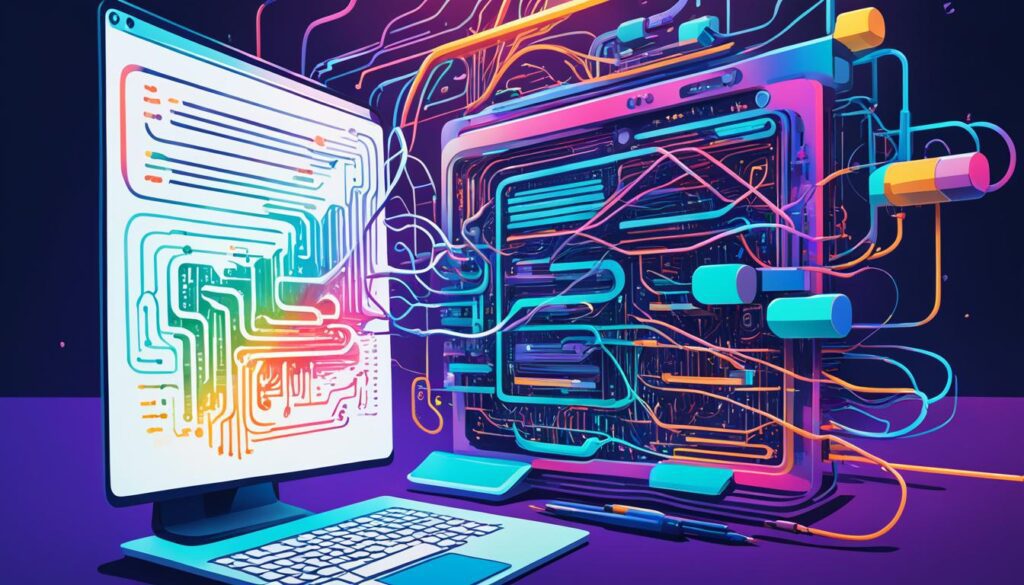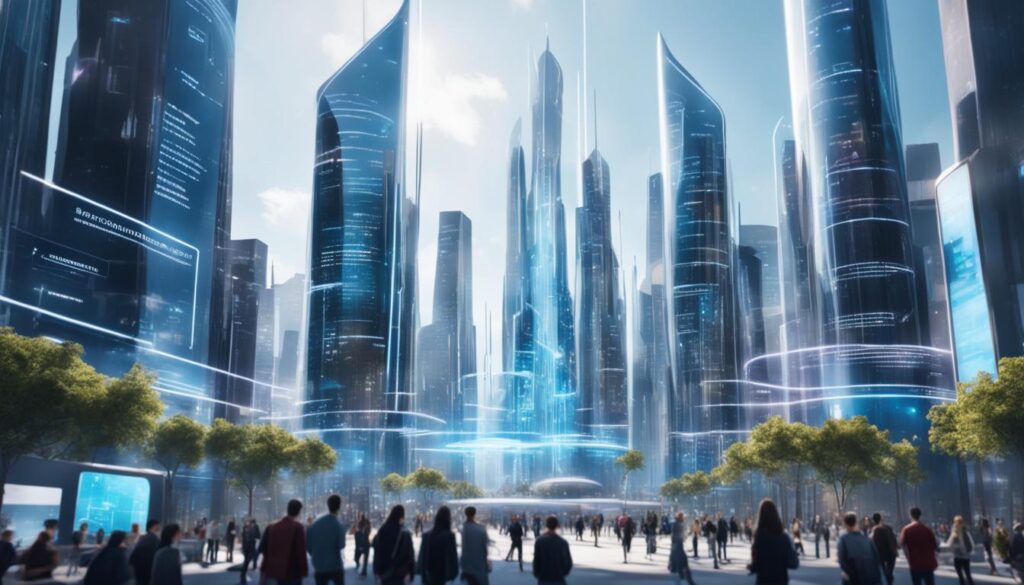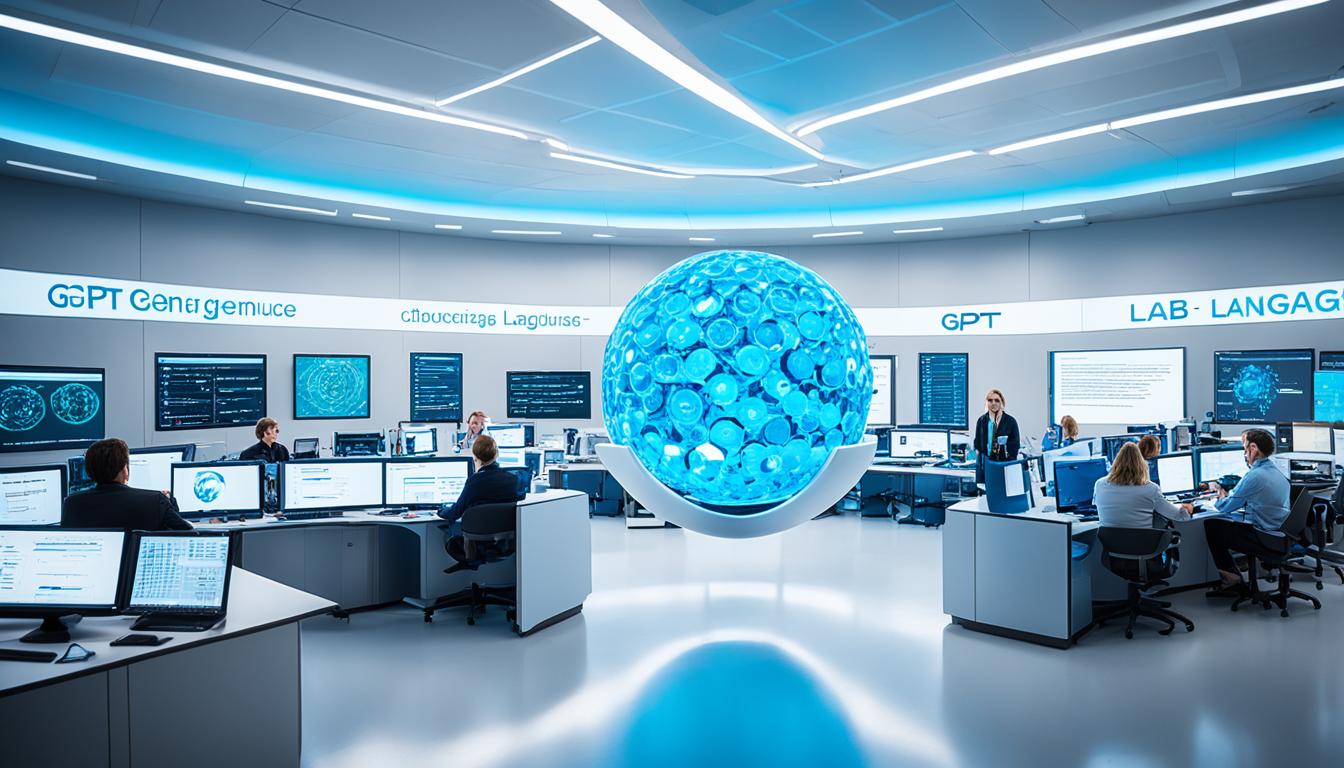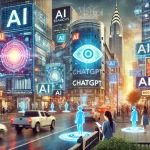The field of artificial intelligence (AI) is rapidly advancing. At the center of this growth is GPT, or Generative Pre-trained Transformer. This incredible technology has changed how we interact with computers. It’s moved us into a new world across many industries, from creative writing to healthcare. In this piece, we will look at what GPT can do now, how it impacts us, and what to expect in the future of AI language models
Key Takeaways
- GPT is a revolutionary language model that has transformed the field of artificial intelligence.
- The article explores the current capabilities of GPT and its impact across different industries.
- Predictions about the future advancements of GPT and its role in shaping the future of AI language models.
- Discover how GPT is enhancing language understanding through contextual awareness and multimodal integration.
- Explore the potential applications of GPT in creative writing, education, healthcare, and customer service.
GPT: The Game-Changing Language Model
Generative Pre-trained Transformer (GPT) is a top-notch language model. It’s changing how we use and understand human language. GPT is being used in many fields, from making content to improving customer service.
Understanding GPT’s Capabilities
GPT is great at understanding and creating text that sounds like a human. It can do tasks like answering questions, translating languages, and generating new text. This shows how well GPT can work with written or spoken language.
The Impact of GPT on Various Industries
GPT is not just about language. It’s making a big difference in businesses and services, making them better and more personal. For instance, in making content, GPT can help write articles or stories, making the process faster and steady. In customer service, it powers chatbots and virtual assistants that make service better and cheaper.
But that’s not all. The healthcare field is using GPT for medical help. It’s making diagnoses, organizing patient records, and helping doctors make better choices. GPT’s potential is huge.
| Industry | GPT Application | Potential Impact |
|---|---|---|
| Content Creation | Automated article and script generation | Increased productivity, consistent output |
| Customer Service | Chatbots and virtual assistants | Improved customer satisfaction, reduced operational costs |
| Healthcare | Medical diagnosis support, patient documentation | Enhanced clinical decision-making, streamlined processes |
As GPT gets better, it will change industries more. Its skill with language is bridging tech and human talk. This bond will open new doors and change our world.
Future of GPT: Advancements and Predictions
Artificial intelligence is evolving fast. GPT models show great promise. They’re changing how we work in many fields. Soon, they will improve even more.
GPT’s future focus is better understanding human language. This means making conversations more real. It’ll especially help in areas like talking to customers, healthcare, and teaching.
Also, GPT might soon work with more than just text. It could use images, audio, and videos too. This would make it super helpful in creative jobs.
Experts believe GPT will grow beyond just reading and texting. It might help solve big problems and make decisions. This would be a big step forward, helping in many fields.
But, we must think about using GPT wisely. We should make sure it’s fair and not biased. Developing GPT in a good way is key to a better future with AI
“The future of GPT holds the potential to transform how we interact with and leverage AI language technology, paving the way for a more intelligent and interconnected world.”
AI is on a path to keep getting better. The future of GPT models is full of possibilities. By improving language skills and adding new features, GPT will change many areas for the better.
Enhancing GPT’s Language Understanding
In the growing field of artificial intelligence, improving GPT’s grasp of language is critical. This includes boosting contextual awareness and adding multimodal integration. These changes will make GPT understand and respond to language much better.
Contextual Awareness and Reasoning
GPT will get better at understanding language in the right context. This advancement will let it pick up on the smaller details in how people talk. Things like the tone, cultural clues, and what’s really meant. So, its answers will fit the conversation spot on, sounding more natural.
It’s also going to improve its ability to think. The plan is to have it make sense of things logically, connect different parts, and think things through deeply. This will make it useful in many jobs and situations.
Multimodal Integration: Beyond Text
GPT will learn from more than just what’s written. It will understand videos, sound, and even touch. This will let it truly get what’s being said in the real world, where we use all sorts of ways to communicate.
GPT will soon understand what it sees in pictures and videos. This will make its answers better by including more about what’s happening. Plus, it will get better at talking, making it easier for us to chat back and forth with it.
| Feature | Description | Potential Impact |
|---|---|---|
| GPT Contextual Awareness | Improving the model’s understanding of language in its proper context, considering factors like tone, cultural references, and implicit meanings. | Enables more accurate and natural-sounding language generation, aligning responses with the specific context of the conversation. |
| GPT Reasoning Capabilities | Empowering the model to draw logical inferences, make contextual associations, and engage in deeper analytical thinking. | Expands the applications of GPT across various industries and use cases, allowing for more sophisticated problem-solving and decision-making. |
| GPT Multimodal Integration | Incorporating visual, auditory, and tactile data to develop a more holistic understanding of communication and language. | Enhances the model’s ability to comprehend and respond to real-world scenarios, where information is often conveyed through multiple modalities. |
These improvements will change how we work with GPT and other language AI. It will lead to more intuitive and versatile apps for many fields.
The Future of GPT in Creative Writing
GPT is a cutting-edge language model. It’s getting better all the time. Because of this, the future of using GPT in creative writing looks very promising. It has the potential to change how writers work, making the creation of stories more innovative and engaging.
The most exciting part about GPT is how it helps in coming up with ideas. GPT creative writing tools act like a writing partner. They help writers think of storylines, create detailed characters, and even write full stories. This lets writers find new inspiration and ways to tell their tales.
Also, the progress in GPT content generation brings about advanced GPT narrative AI systems. These AI systems can develop stories that are interesting and easy to follow. They could be used as a basis for a writer’s work or as stories on their own. They might change what it means to be a writer and how stories are made.
“The integration of GPT in creative writing has the potential to unlock new realms of imagination and storytelling, transforming the way we approach the art of writing.”
Yet, using GPT in creative writing brings up some concerns. We need to think about the impact on creativity and the writing profession. It’s important to find a way that technology and human creativity can work together in a positive way.

Looking ahead, GPT’s role in creative writing is full of possibilities. It could improve how stories are made and change the storytelling scene. This advanced tool is set to make a notable difference in the world of literature.
GPT and the Future of Education
The use of GPT technology in education is promising. GPT tools can change how we learn, making it personalized and adaptive. This can transform how we teach and learn.
Personalized Learning Experiences
GPT models create unique learning paths for students. They look at how each student learns best and what they like. Then GPT tools adjust learning material and speed to fit each student perfectly.
This way, students stay more interested, remember more, and learn faster.
- Adaptive content curation: GPT models pick up on how a student is doing and suggest materials that fit them best.
- Personalized feedback and guidance: Virtual tutors powered by GPT offer help that’s just right for each student, tackling their problems directly.
- Adaptive pacing: These systems change how fast they teach a subject based on how well a student is doing. This keeps everyone learning at a good speed.
With GPT, learning becomes more fun and suited to each student’s needs.
Adaptive Tutoring with GPT
Advanced GPT tutors can support students in a very personalized way. They work alongside regular class lessons. These AI tutors talk in a way that feels natural. They can read what a student needs and answer in a way that fits them.
- Real-time support: GPT tutors are there round the clock, ready to help with any question or issue a student might have.
- Multilingual capabilities: GPT understands and speaks many languages. This makes it easier for students who don’t speak English as their first language to get help.
- Continuous learning: These GPT tutors keep getting better by learning from each student they help.
GPT can make learning more tailored and helpful. It helps students learn better and teachers teach better.
| Benefit | Description |
|---|---|
| Personalized Learning | GPT-powered platforms can tailor content and pace to individual student needs, improving engagement and outcomes. |
| Adaptive Tutoring | GPT-based tutors can provide real-time, multilingual support and guidance, complementing classroom instruction. |
| Continuous Improvement | GPT models can learn from each interaction, continuously enhancing their understanding and responses. |
“GPT has the potential to transform the educational landscape, empowering students and educators alike with personalized, adaptive learning experiences.”
GPT is blazing a new trail in the way we learn and teach. It helps teachers make learning more exciting and personal for students of all kinds.
Future of GPT in Healthcare
The healthcare field stands on the brink of big change thanks to GPT technology. It brings new ways to use language to solve health problems. By using GPT, we can make medical diagnoses easier, help patients understand their health better, and do healthcare jobs more efficiently.
Natural Language Processing for Medical Diagnoses
GPT shines in helping doctors figure out what’s wrong with a patient. It takes in what patients say and what tests show, then helps doctors find possible issues faster and more accurately. This is a big step in making healthcare work better.
It’s especially useful when doctors have lots of data to go through. Like, a patient’s history, many symptoms, and different tests. GPT quickly spots the important bits, giving doctors a clear path for what to do next.
| Benefit | Description |
|---|---|
| Improved Diagnostic Accuracy | GPT-powered NLP can analyze patient data more thoroughly, identifying subtle connections and patterns that may be overlooked by human clinicians. |
| Enhanced Efficiency | Automating the processing of medical data and generating insights can significantly reduce the time healthcare providers spend on administrative tasks, allowing them to focus more on patient care. |
| Personalized Recommendations | GPT models can tailor their outputs to individual patient profiles, providing personalized treatment suggestions and care plans. |
With more and more health data to handle, having GPT help is a real plus. GPT-based tools can back up doctors, making sure patients get the best care possible.
The Future of GPT in Customer Service
In customer service, GPT-powered chatbots and virtual helpers could change everything. The tech is getting better, offering customers more personalized help and faster support. It could really change the game for how companies talk to their customers.
Conversational AI and Virtual Assistants
GPT-based systems are shaking things up. They offer smart, natural conversations that feel like talking to a real person. This means they can help with a lot of different questions and jobs. They work 24/7, answer quickly, and let human staff deal with trickier problems.
These systems can get smarter over time. They learn from each chat, working better and better. This leads to help that feels just for you, meeting your special needs and likes.
| Feature | GPT-based Virtual Assistant | Traditional Customer Service |
|---|---|---|
| Response Time | Instant | Variable, often slower |
| Personalization | High, based on customer history and preferences | Limited, based on agent knowledge |
| Availability | 24/7 | Dependent on business hours |
| Language Understanding | Advanced, able to handle complex queries | Dependent on agent skills |
As virtual helpers get better, they’ll become key in excellent customer service. They’ll make customers happier and make business smoother.
The future looks bright for GPT in customer service. It’s all about giving businesses powerful ways to speak with customers. By using GPT-based chatbots and helpers, companies can really impress today’s tech-savvy customers.
Ethical Considerations and Challenges
Advances in GPT and similar models raise ethical concerns. GPT ethics and GPT fairness issues are crucial. Without care, these systems can introduce bias and unfairness.
Developing and deploying AI language models responsibly is essential. Large data sets used for training can mirror society’s biases. This mirrors issues like stereotypes and discrimination.
Bias and Fairness in Language Models
Experts have found different types of bias in AI models. These include:
- Demographic bias: The model may show a preference based on gender, race, or age.
- Contextual bias: The model’s answers can be tied to the situation it’s in, leading to varied or biased outcomes.
- Representational bias: Model training may not cover enough diverse human experiences, resulting in skewed results.
Dealing with GPT bias and GPT fairness is tough. Many strategies focus on collecting better data, designing models well, and refining the results. The field of addressing bias in AI models is always changing. Hence, staying alert and researching are critical to meet ethical guidelines.
| Bias Type | Description | Example |
|---|---|---|
| Demographic Bias | Preferences or assumptions based on demographic characteristics | The model linking certain jobs or traits to specific genders |
| Contextual Bias | Influence of the specific context or environment | The model offering different answers based on where the user is or what language they speak |
| Representational Bias | Inadequate representation of diverse human experiences in the training data | The model not understanding cultural or language differences not in its training data |
Recognizing and tackling bias and fairness issues in AI models is key. It’s vital for both the technology and our morals. Ensuring equal treatment and less bias in these systems is essential.
The Future of GPT: What’s Next in AI Language
GPT, a key AI language model, is changing how we view technology and language. It has the power to transform many fields, like creativity and education, in exciting ways. New developments in GPT promise even more possibilities for the future.
One big step is making GPT understand language better. This means it can have smarter conversations. Plus, it will start to use pictures and sound to say more than just words.
In the world of writing, GPT will be a huge help, aiding in story creation and content writing. In education, GPT will make learning personalized, changing how students learn and teachers teach.
Talking about the medical field, GPT can help make better diagnoses, improve how doctors talk with patients, and help health staff make decisions. In customer service, GPT will change how businesses and people talk, making exchanges more personal and smooth.
But, there are challenges, too, especially when it comes to fairness and bias. Making AI technology that works well and does good for everyone needs careful thought. This is a key focus for the future.
The future of GPT and AI language technology holds many chances for better learning, health care, and customer service. The progress in GPT is set to make a big difference in our daily lives, offering new ways to use language effectively.

| Key GPT Advancements | Anticipated Impact |
|---|---|
| Improved Contextual Awareness | Enhanced ability to understand and respond to nuanced language, leading to more natural and intelligent conversations. |
| Multimodal Integration | Expanded capabilities to comprehend and generate content across various media, including images, audio, and video. |
| Personalized Learning Experiences | Tailored educational approaches that cater to individual student needs and preferences, driving improved learning outcomes. |
| Automated Medical Diagnostics | More accurate and efficient identification of health conditions through natural language processing of patient data. |
GPT’s journey is just starting. The shift it brings to AI language technology is significant. It will change how we use language in the future, creating new digital experiences.
Conclusion
This article looked at the bright future of GPT, a cutting-edge language model. It’s set to change many fields and how we use tech. GPT will better our understanding of words, boost creative writing, and change learning and customer help.
The potential of GPT is huge. It promises to keep evolving, thanks to new discoveries. It will combine with other smart tech, like knowing more about the context and better reasoning. This growth will affect many parts of life, from learning that fits you better to improved medical checks.
GPT’s future is full of chances. It will refine how we see and use AI over time. The journey will bring big improvements. These will change how we talk, work on things, and fix issues, leading to a smarter and tech-filled tomorrow.







